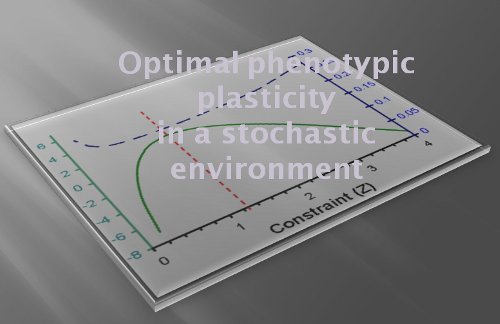Sample menu:
Optimization of phenotypic plasticity
and minimization of the cost/score ratio.

Phenotypic
plasticity is a general and common feature, probably shared by most
organisms. This concept refers to the ability of genetically identical
organisms to change their phenotype in response to environmental
changes in space and time. These changes are favoured because they
reduce the fitness variance from generation to generation.
Energetic cost is a constraint which limits the evolution and the development of plasticity. Among several causes of such a cost, several authors emphasize the “production cost”, which should be considered only if the cost of production by plastic genomes exceeds those for fixed genotypes producing the same phenotype. This means that the variance associated to the average genome expression has an energetic price. The wider the variance, the higher the cost.
We focus on the estimation of the best cost/benefit ratio of plasticity in the context of fluctuant (stochastic) environments. Since the energetic cost paid is positively correlated to the variance of the response to environmental fluctuations, the arising question is: what is the optimal variance of a phenotype undergoing a fluctuating environment which minimises the cost/benefit ratio?
Energetic cost is a constraint which limits the evolution and the development of plasticity. Among several causes of such a cost, several authors emphasize the “production cost”, which should be considered only if the cost of production by plastic genomes exceeds those for fixed genotypes producing the same phenotype. This means that the variance associated to the average genome expression has an energetic price. The wider the variance, the higher the cost.
We focus on the estimation of the best cost/benefit ratio of plasticity in the context of fluctuant (stochastic) environments. Since the energetic cost paid is positively correlated to the variance of the response to environmental fluctuations, the arising question is: what is the optimal variance of a phenotype undergoing a fluctuating environment which minimises the cost/benefit ratio?
Authors : Patrick Coquillard, Alexandre Muzy and Francine Diener
Downloads :
Paper in Ecological modelling (2012) and supplementary info.
A presentation (in English, with comments in french)